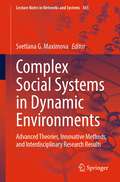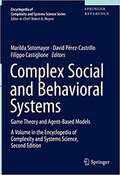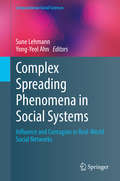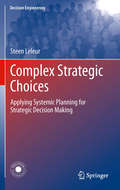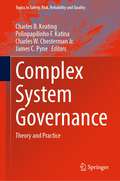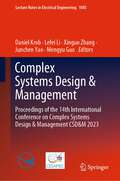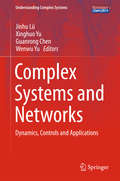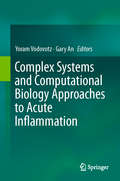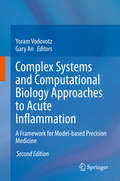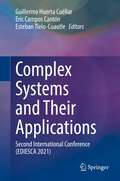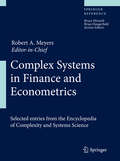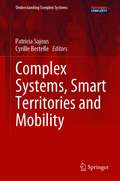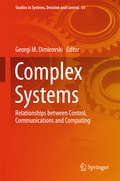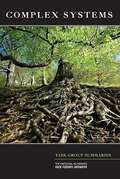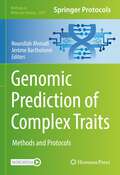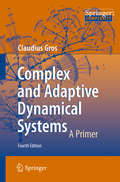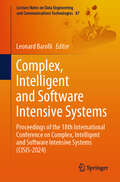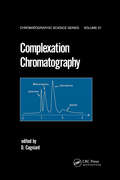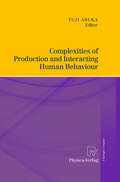- Table View
- List View
Complex Social Systems in Dynamic Environments: Advanced Theories, Innovative Methods, and Interdisciplinary Research Results (Lecture Notes in Networks and Systems #365)
by Svetlana G. MaximovaThis edited book considers social systems as self-organizing structures that reproduce new structural elements endowed with certain functional connections. The authors analyze innovative processes in social systems, leading to the sustainable convergence of knowledge and the emergence of technologies that improve the level of material well-being in society. The book summarizes research results in the field of digitalization and reveals deep connections with social problems. In addition, the book presents a whole array of innovative research on social systems management and the application of knowledge and intelligence to the solution of social problems. The contributing scholars and practitioners reflect on various types of social systems and assess the influence of disruptive factors from natural and coupled human-natural environments, discussing possible mechanisms for their neutralization. Sustainable development of social systems is among the most important tasks facing the contemporary world. The contributed book highlights challenges to the sustainability of social systems, draws sociotechnical images of the future world order generated by the rapid development of intellectual technologies, and critically analyzes promising concepts for more sustainable social future. Among the discussed topics in the book are social governance, digital economy, technological landscapes, social systems modeling and simulation, cyber-social systems, knowledge-based innovation systems, complex processes in social systems, institutional arrangements, and other advancing research areas. The high-quality and original studies presented in the book appeal to those interested in broadening their perspectives on complexity science, complex social systems research, complex systems management, advanced technological development in social systems, etc. Since the book is rich with well-thought theories, advanced research approaches, and interdisciplinary research results, it becomes a great source of new ideas and insights on complex social systems.
Complex Social and Behavioral Systems: Game Theory and Agent-based Models (Encyclopedia of Complexity and Systems Science)
by Filippo Castiglione Marilda Sotomayor David Perez-CastrilloThis volume in the Encyclopedia of Complexity and Systems Science, Second Edition, combines the main features of Game Theory, covering most of the fundamental theoretical aspects under the cooperative and non-cooperative approaches, with the procedures of Agent-Based Modeling for studying complex systems composed of a large number of interacting entities with many degrees of freedom. <p><p>In Game Theory, the cooperative approach focuses on the possible outcomes of the decision-makers’ interaction by abstracting from the "rational" actions or decisions that may lead to these outcomes. The non-cooperative approach focuses on the actions that the decision-makers can take. As John von Neumann and Oskar Morgenstern argued in their path-breaking book of 1944 entitled Theory of Games and Economic Behavior, most economic questions should be analyzed as games. The models of game theory are abstract representations of a number of real-life situations and have applications to economics, political science, computer science, evolutionary biology, social psychology, and law among others. Agent-Based Modeling (ABM) is a relatively new computational modeling paradigm which aims to construct the computational counterpart of a conceptual model of the system under study on the basis of discrete entities (i.e., the agent) with some properties and behavioral rules, and then to simulate them in a computer to mimic the real phenomena. Given the relative immaturity of this modeling paradigm, and the broad spectrum of disciplines in which it is applied, a clear cut and widely accepted definition of high level concepts of agents, environment, interactions and so on, is still lacking. <p><p>This volume explores the state-of-the-art in the development of a real ABM ontology to address the epistemological issues related to this emerging paradigm for modeling complex systems.
Complex Spreading Phenomena in Social Systems: Influence and Contagion in Real-World Social Networks (Computational Social Sciences)
by Yong-Yeol Ahn Sune LehmannThis text is about spreading of information and influence in complex networks. Although previously considered similar and modeled in parallel approaches, there is now experimental evidence that epidemic and social spreading work in subtly different ways. While previously explored through modeling, there is currently an explosion of work on revealing the mechanisms underlying complex contagion based on big data and data-driven approaches.This volume consists of four parts. Part 1 is an Introduction, providing an accessible summary of the state of the art. Part 2 provides an overview of the central theoretical developments in the field. Part 3 describes the empirical work on observing spreading processes in real-world networks. Finally, Part 4 goes into detail with recent and exciting new developments: dedicated studies designed to measure specific aspects of the spreading processes, often using randomized control trials to isolate the network effect from confounders, such as homophily. Each contribution is authored by leading experts in the field. This volume, though based on technical selections of the most important results on complex spreading, remains quite accessible to the newly interested. The main benefit to the reader is that the topics are carefully structured to take the novice to the level of expert on the topic of social spreading processes. This book will be of great importance to a wide field: from researchers in physics, computer science, and sociology to professionals in public policy and public health.
Complex Strategic Choices: Applying Systemic Planning for Strategic Decision Making (Decision Engineering)
by Steen LeleurEffective decision making requires a clear methodology, particularly in complex, globally relevant situations. Institutions and companies in all disciplines and sectors are faced with increasingly multi-faceted areas of uncertainty which cannot always be effectively handled by traditional strategies. Complex Strategic Choices provides clear principles and methods which can guide and support strategic decision to face modern challenges. By considering ways in which planning practices can be renewed and exploring the possibilities for acquiring awareness and tools to add value to strategic decision making, Complex Strategic Choices presents a methodology which is further illustrated by a number of case studies and example applications. Dr. Techn. Steen Leleur has adapted previously established research based on feedback and input from various conferences, journals and students resulting in new material stemming from and focusing on practical application of systemic planning. The outcome is a coherent and flexible approach named systemic planning. The inclusion of both the theoretical and practical aspects of systemic planning makes this book a key resource for researchers and students in the field of planning and decision analysis as well as practitioners dealing with strategic analysis and decision making. More broadly, Complex Strategic Choices acts as guide for professionals and students involved in complex planning tasks across several fields such as business and engineering.
Complex System Governance: Theory and Practice (Topics in Safety, Risk, Reliability and Quality #40)
by Polinpapilinho F. Katina Charles B. Keating Charles W. Chesterman Jr. James C. PyneThis book explores Complex System Governance (CSG)—an emerging field concerned with the design, execution, and evolution of essential functions necessary to ensure continued viability of a system. The book focuses on three primary development areas to better understand and utilize current developments CSG. First, the conceptual foundations for CSG are developed, from systems theory, management cybernetics, and governance. Second, a set of critical CSG topics are examined from conceptual as well as practice perspectives. Third, several development and application issues are discussed. Ultimately, CSG is positioned as an emerging field with strong theoretical grounding and significant implications for improving practices and performance to better address complex systems and their problems.
Complex Systems Design & Management: Proceedings of the 14th International Conference on Complex Systems Design & Management CSD&M 2023 (Lecture Notes in Electrical Engineering #1085)
by Daniel Krob Xinguo Zhang Lefei Li Junchen Yao Mengyu GuoThis book contains all refereed papers accepted during the 14th International Conference on Complex Systems Design & Management CSD&M 2023 that took place in Beijing, People’s Republic of China by the end October 2023. Mastering complex systems requires an integrated understanding of industrial practices as well as sophisticated theoretical techniques and tools. This explains the creation of an annual go-between European and Asian forum dedicated to academic researchers and industrial actors working on complex industrial systems architecting, modeling and engineering. These proceedings cover the most recent trends in the emerging field of complex systems, both from an academic and professional perspective. A special focus was put this year on “New Trends in Complex Systems Engineering.” The CSD&M series of conferences were initiated under the guidance of CESAM Community in Europe, managed by CESAMES. Its Asian version took place in Singapore for three consecutive sessions during 2014 and 2018. The fourth Asian edition was held in Beijing in hybrid with the Chinese Society of Aeronautics and Astronautics (CSAA) as the co-organizer in 2021. Since 2023, its European and Asian conferences merge into one, taking place in China and Europe in turn. CESAM Community aims in organizing the sharing of good practices in systems architecting and model-based systems engineering (MBSE) and certifying the level of knowledge and proficiency in this field through the CESAM certification. The CESAM systems architecting, and model-based systems engineering (MBSE) certification is especially currently the most disseminated professional certification in the world in this domain through more than 3,000 real complex system development projects on which it was operationally deployed and around 10,000 engineers who were trained on the CESAM framework at international level.
Complex Systems Modeling and Simulation in Economics and Finance (Springer Proceedings in Complexity)
by Shu-Heng Chen Ying-Fang Kao Ragupathy Venkatachalam Ye-Rong DuThis title brings together frontier research on complex economic systems, heterogeneous interacting agents, bounded rationality, and nonlinear dynamics in economics. The book contains the proceedings of the CEF2015 (21st Computing in Economics in Finance), held 20-22 June 2015 in Taipei, Taiwan, and addresses some of the important driving forces for various emergent properties in economies, when viewed as complex systems. The breakthroughs reported in this book are a result of an interdisciplinary approach and simulation remains the unifying theme for these papers as they deal with a wide range of topics in economics. The text is a valuable addition to the efforts in promoting the complex systems view in economic science. The computational experiments reported in the book are both transparent and replicable.Complex System Modeling and Simulation in Economics and Finance is useful for graduate courses of complex systems, with particular focus on economics and finance. At the same time it serves as a good overview for researchers who are interested in the topic.
Complex Systems and Networks: Dynamics, Controls and Applications (Understanding Complex Systems)
by Guanrong Chen Jinhu Lü Xinghuo Yu Wenwu YuThis elementary book provides some state-of-the-art research results on broad disciplinary sciences on complex networks. It presents an in-depth study with detailed description of dynamics, controls and applications of complex networks. The contents of this book can be summarized as follows. First, the dynamics of complex networks, for example, the cluster dynamic analysis by using kernel spectral methods, community detection algorithms in bipartite networks, epidemiological modeling with demographics and epidemic spreading on multi-layer networks, are studied. Second, the controls of complex networks are investigated including topics like distributed finite-time cooperative control of multi-agent systems by applying homogenous-degree and Lyapunov methods, composite finite-time containment control for disturbed second-order multi-agent systems, fractional-order observer design of multi-agent systems, chaos control and anticontrol of complex systems via Parrondos game and many more. Third, the applications of complex networks provide some applicable carriers, which show the importance of theories developed in complex networks. In particular, a general model for studying time evolution of transition networks, deflection routing in complex networks, recommender systems for social networks analysis and mining, strategy selection in networked evolutionary games, integration and methods in computational biology, are discussed in detail.
Complex Systems and Computational Biology Approaches to Acute Inflammation
by Gary An Yoram VodovotzThe difficulty in achieving effective translation of basic mechanistic biomedical knowledge into effective therapeutics, is the greatest challenge in biomedical research. Nowhere is this more apparent than in the reductionist approaches to understanding and manipulating the acute inflammatory response in the settings of sepsis, trauma/hemorrhage, wound healing, and related processes. This book discusses complex systems and computational biology methods and approaches that have advanced sufficiently to allow for knowledge generation, knowledge integration, and clinical translation in the settings of complex diseases related to the inflammatory response. Well-regulated, self-resolving inflammation is necessary for the appropriate communication and resolution of infection and trauma, and for maintenance of proper physiology and homeostasis. In contrast, self-sustaining inflammation drives the pathobiology of the aforementioned diseases. It is now increasingly recognized that controlling and reprogramming inflammation in order to reap the benefits of this evolutionarily-conserved process is preferred to simply abolishing indiscriminately.
Complex Systems and Computational Biology Approaches to Acute Inflammation: A Framework for Model-based Precision Medicine
by Gary An Yoram VodovotzThis second edition expands upon and updates the vital research covered in its predecessor, by presenting state-of-the-art multidisciplinary and systems-oriented approaches to complex diseases arising from and driven by the acute inflammatory response. The chapters in this volume provide an introduction to different types of computational modeling, and how these methods can be applied to specific inflammatory diseases, with a focus on providing readers a roadmap for integrating advanced mathematical and computational techniques with traditional experimental methods. In this second edition, we cover both well-established and emerging modeling methods, especially state-of-the-art machine learning approaches and the integration of data-driven and mechanistic modeling.This volume introduces the concept of Model-based Precision Medicine as an alternative approach to the current view of Precision Medicine, based on leveraging mechanistic computational modeling to decrease cost while increasing the information value of the data being obtained.By presenting the role of computational modeling as an integrated component of the research process, Complex Systems and Computational Biology Approaches to Acute Inflammation: A Framework for Model-based Precision Medicine offers a window into the recent past, the present, and the future of computationally-augmented biomedical research.
Complex Systems and Their Applications: Fifth International Conference (EDIESCA 2024)
by Esteban Tlelo-Cuautle Guillermo Huerta-Cuellar Eric Campos-Canton Hector Eduardo Gilardi-VelazquezThis book compiles select articles presented during the Fifth Meeting for Dissemination and Research in the Study of Complex Systems and their Applications (EDIESCA 2024). EDIESCA arises from the need to foster academic and research groups that carry out scientific research and further technological development at the national and international level. The meeting promotes participation among graduate students, industry specialists, and researchers to establish collaborations on the study of complex systems and their applications that may have a strong impact on the development of new projects. The study and characterization of systems with non-linear and/or chaotic behavior has been of great interest to researchers around the world, for which various applications have been developed. The dynamic study of chaotic systems of different models, for example, such as Rössler, Lorenz, and Chua to name a few, has generated important advances in areas of research on chemical reactions, meteorological behavior, design of electronic devices, and other applications. Among the best-known results, the study of systems that show multistability and hidden attractors has been a subject of interest in recent years, generating new lines for research.
Complex Systems and Their Applications: Fourth International Conference (EDIESCA 2023)
by Esteban Tlelo-Cuautle Eric Campos-Cantón Guillermo Huerta-Cuellar Ernesto Zambrano-SerranoThis book is a compilation of scientific articles written by recognized researchers participating in the Fourth Conference on the Study of Complex Systems and their Applications (EDIESCA 2023), held in Monterrey, Mexico. EDIESCA arose from the need for academic and research groups that carry out this scientific research to disseminate their results internationally. The study and characterization of systems with non-linear and/or chaotic behavior has been of great interest to researchers around the world, for which many important results have been obtained with various applications. The dynamic study of chaotic oscillators of different models, such as Rössler, Lorenz, and Chua, has generated important advances in the understanding of chemical reactions, meteorological behavior, design of electronic devices, and other applications. Topics at the event included applications for communications systems by masking techniques, financial behavior, networks analysis, nonlinear lasers, numerical modeling, electronic design, and other interesting topics in the area of complex systems. Additionally, there are results on numerical simulation and electronic designs to generate complex dynamic behaviors.
Complex Systems and Their Applications: Second International Conference (EDIESCA 2021)
by Esteban Tlelo-Cuautle Guillermo Huerta Cuéllar Eric Campos CantónThis book is a compilation of scientific articles written by recognized researchers, and select students, participating in the Second Conference on the Study of Complex Systems and their Applications (EDIESCA 2021). EDIESCA 2021 arose from the need for academic and research groups that carry out this scientific research to disseminate their results internationally. The study and characterization of systems with non-linear and/or chaotic behavior has been of great interest to researchers around the world, for which many important results have been obtained with various applications. The dynamic study of chaotic oscillators of different models, such as Rössler, Lorenz, and Chua, has generated important advances in understanding of chemical reactions, meteorological behavior, design of electronic devices, and other applications. Topics at the event included applications for communications systems by masking techniques, financial behavior, networks analysis, nonlinear lasers, numerical modeling, electronic design, and other interesting topics in the area of complex systems. Additionally, there are results on numerical simulation and electronic designs to generate complex dynamic behaviors.
Complex Systems in Finance and Econometrics
by Robert A. MeyersComplex Systems in Finance and Econometrics is an authoritative reference to the basic tools and concepts of complexity and systems theory as applied to an understanding of complex, financial-based business and social systems. Fractals, nonlinear time series modeling, cellular automata, game theory, network theory and statistical physics are among the essential tools and techniques for predicting, monitoring, evaluating, managing, and decision-making in a wide range of fields from health care, poverty alleviation, and energy and the environment, to manufacturing and quality assurance, model building, organizational learning. and macro and microeconomics. Sixty of the world's leading experts present 47 articles for an audience of advanced undergraduate and graduate students, professors, and professionals in all of these fields.
Complex Systems, Smart Territories and Mobility (Understanding Complex Systems)
by Patricia Sajous Cyrille BertelleThis book reflects the outcome of contribution by the plural community and of the interactions between disciplines. With the mass of data available through Information and Communication Technologies (ICT) in an unprecedented quantity since the Human History, it is now possible to access dimensions of knowledge that, though not hidden, could not be grasped in the same way in the past. The question of how this information can be used for the benefit of institutional and economic actors to foster the development of a territory. Tackling the issue from a resolutely interdisciplinary perspective, the authors explore the theories and methods of complex systems in order to discuss how they can contribute in these new circumstances to territorial intelligence and to the development practices in which it is embodied. This book illustrates how today’s research explores the multiple facets of territorial systems in order to reproduce their richness. It invites readers to learn about the challenges, ideas, results and advances present in this domain.
Complex Systems: Relationships between Control, Communications and Computing (Studies in Systems, Decision and Control #55)
by Georgi M. DimirovskiThis book gives a wide-ranging description of the many facets of complex dynamic networks and systems within an infrastructure provided by integrated control and supervision: envisioning, design, experimental exploration, and implementation. The theoretical contributions and the case studies presented can reach control goals beyond those of stabilization and output regulation or even of adaptive control. Reporting on work of the Control of Complex Systems (COSY) research program, Complex Systems follows from and expands upon an earlier collection: Control of Complex Systems by introducing novel theoretical techniques for hard-to-control networks and systems. The major common feature of all the superficially diverse contributions encompassed by this book is that of spotting and exploiting possible areas of mutual reinforcement between control, computing and communications. These help readers to achieve not only robust stable plant system operation but also properties such as collective adaptivity, integrity and survivability at the same time retaining desired performance quality. Applications in the individual chapters are drawn from: * the general implementation of model-based diagnosis and systems engineering in medical technology, in communication, and in power and airport networks; * the creation of biologically inspired control brains and safety-critical human-machine systems, * process-industrial uses; * biped robots; * large space structures and unmanned aerial vehicles; and * precision servomechanisms and other advanced technologies. Complex Systems provides researchers from engineering, applied mathematics and computer science backgrounds with innovative theoretical and practical insights into the state-of-the-art of complex networks and systems research. It employs physical implementations and extensive computer simulations. Graduate students specializing in complex-systems
Complex Systems: Task Group Summaries
by The National AcademiesThe National Academies Keck Futures Initiative was launched in 2003 to stimulate new modes of scientific inquiry and break down the conceptual and institutional barriers to interdisciplinary research. At the Conference on Complex Systems, participants were divided into twelve interdisciplinary working groups. The groups spent nine hours over two days exploring diverse challenges at the interface of science, engineering, and medicine. The groups included researchers from science, engineering, and medicine, as well as representatives from private and public funding agencies, universities, businesses, journals, and the science media. The groups needed to address the challenge of communicating and working together from a diversity of expertise and perspectives as they attempted to solve complicated, interdisciplinary problems in a relatively short time. The summaries contained in this volume describe the problem and outline the approach taken, including what research needs to be done to understand the fundamental science behind the challenge, the proposed plan for engineering the application, the reasoning that went into it and the benefits to society of the problem solution.
Complex Trait Prediction: Methods and Protocols (Methods in Molecular Biology #2467)
by Nourollah Ahmadi Jérôme BartholoméThis volume explores the conceptual framework and the practical issues related to genomic prediction of complex traits in human medicine and in animal and plant breeding. The book is organized into five parts. Part One reminds molecular genetics approaches intending to predict phenotypic variations. Part Two presents the principles of genomic prediction of complex traits, and reviews factors that affect its reliability. Part Three describes genomic prediction methods, including machine-learning approaches, accounting for different degree of biological complexity, and reviews the associated computer-packages. Part Four reports on emerging trends such as phenomic prediction and incorporation into genomic prediction models of “omics” data and crop growth models. Part Five is dedicated to lessons learned from cases studies in the fields of human health and animal and plant breeding, and to methods for analysis of the economic effectiveness of genomic prediction. Written in the highly successful Methods in Molecular Biology series format, the book provides theoretical bases and practical guidelines for an informed decision making of practitioners and identifies pertinent routes for further methodological researches. Cutting-edge and thorough, Complex Trait Predictions: Methods and Protocols is a valuable resource for scientists and researchers who are interested in learning more about this important and developing field.Chapters 3, 9, 13, 14, and 21 are available open access under a Creative Commons Attribution 4.0 International License via link.springer.com.
Complex and Adaptive Dynamical Systems: A Comprehensive Introduction
by Claudius GrosThis textbook offers a comprehensive introduction to the concepts underpinning our modern understanding of complex and emergent behavior. Mathematical methods necessary for the discussion are introduced and explained on the run. All derivations are presented step-by-step. This new fifth edition has been fully revised and includes a new chapter, a range of new sections, figures and exercises. The Solution chapter has been reorganized for clarity.The core aspects of modern complex system sciences are presented in the first chapters, covering the foundations of network- and dynamical system theory, with a particular focus on scale-free networks and tipping phenomena. The notion of deterministic chaos is treated together with bifurcation theory and the intricacies of time delays. Modern information theoretical principles are discussed in further chapters, together with the notion of self-organized criticality, synchronization phenomena, and a game-theoretical treatment of the tragedy of the commons. The dynamical systems view of modern machine learning is presented in a new chapter.Chapters include exercises and suggestions for further reading. The textbook is suitable for graduate and advanced undergraduate students. The prerequisites are the basic mathematical tools of courses in natural sciences, computer science or engineering.
Complex and Adaptive Dynamical Systems: A Primer (Springer Complexity Ser.)
by Claudius GrosDiscover a wide range of findings in quantitative complex system science that help us make sense of our complex world. Written at an introductory level, the book provides an accessible entry into this fascinating and vitally important subject.
Complex, Intelligent and Software Intensive Systems: Proceedings of the 18th International Conference on Complex, Intelligent and Software Intensive Systems (CISIS-2024) (Lecture Notes on Data Engineering and Communications Technologies #87)
by Leonard BarolliSoftware Intensive Systems are systems, which heavily interact with other systems, sensors, actuators, devices, other software systems and users. More and more domains are involved with software intensive systems, e.g. automotive, telecommunication systems, embedded systems in general, industrial automation systems and business applications. Moreover, the outcome of web services delivers a new platform for enabling software intensive systems. Complex Systems research is focused on the overall understanding of systems rather than its components. Complex Systems are very much characterized by the changing environments in which they act by their multiple internal and external interactions. They evolve and adapt through internal and external dynamic interactions. The development of Intelligent Systems and agents, which is each time more characterized by the use of ontologies and their logical foundations build a fruitful impulse for both Software Intensive Systems and Complex Systems. Recent research in the field of intelligent systems, robotics, neuroscience, artificial intelligence, and cognitive sciences are very important factor for the future development and innovation of software intensive and complex systems. The aim of the volume “Complex, Intelligent and Software Intensive Systems” is to deliver a platform of scientific interaction between the three interwoven challenging areas of research and development of future ICT-enabled applications: Software Intensive Systems, Complex systems and Intelligent Systems.
Complex, Intelligent and Software Intensive Systems: Proceedings of the 19th International Conference on Complex, Intelligent, and Software Intensive Systems (CISIS-2025), Volume 1 (Lecture Notes on Data Engineering and Communications Technologies #260)
by Isaac Woungang Leonard Barolli Tomoya EnokidoThis book aims to deliver a platform of scientific interaction between the three interwoven challenging areas of research and development of future ICT-enabled applications: Software intensive systems, complex systems, and intelligent systems.Software intensive systems are systems which heavily interact with other systems, sensors, actuators, devices, other software systems and users. More and more domains are involved with software intensive systems, e.g., automotive systems, telecommunication systems, embedded systems in general, industrial automation systems, and business applications. Moreover, the outcome of web services delivers a new platform for enabling software intensive systems. Complex systems research is focused on the overall understanding of systems rather than their components. Complex systems are very much characterized by the changing environments in which they act by their multiple internal and external interactions. They evolve and adapt through internal and external dynamic interactions.The development of intelligent systems and agents which can be characterized by ontologies and their logical foundations builds a fruitful impulse for both software intensive systems and complex systems. Recent research in the field of intelligent systems, robotics, neuroscience, artificial intelligence, and cognitive sciences are very important factors for the future development and innovation of software intensive and complex systems.
Complex, Intelligent and Software Intensive Systems: Proceedings of the 19th International Conference on Complex, Intelligent, and Software Intensive Systems (CISIS-2025), Volume 2 (Lecture Notes on Data Engineering and Communications Technologies #261)
by Isaac Woungang Leonard Barolli Tomoya EnokidoSoftware intensive systems are systems which heavily interact with other systems, sensors, actuators, devices, other software systems and users. More and more domains are involved with software intensive systems, e.g., automotive systems, telecommunication systems, embedded systems in general, industrial automation systems and business applications. Moreover, the outcome of web services delivers a new platform for enabling software intensive systems. Complex systems research is focused on the overall understanding of systems rather than their components. Complex systems are very much characterized by the changing environments in which they act by their multiple internal and external interactions. They evolve and adapt through internal and external dynamic interactions.The development of intelligent systems and agents, which can be characterized by ontologies and their logical foundations builds a fruitful impulse for both software intensive systems and complex systems. Recent researches in the field of intelligent systems, robotics, neuroscience, artificial intelligence, and cognitive sciences are very important factors for the future development and innovation of software intensive and complex systems.The aim of the book is to deliver a platform of scientific interaction between the three interwoven challenging areas of research and development of future ICT-enabled applications: software intensive systems, complex systems, and intelligent systems.
Complexation Chromatography (Chromatographic Science Ser. #57)
by D. CagniantConsiders three fundamental aspects of molecular interactions important in chromatography, taking care not to duplicate information readily available in other references. Surveys the basic factors involved in complex formation, which governs the retention mechanism and selectivity in either donor or
Complexities of Production and Interacting Human Behaviour
by Yuji ArukaAs the real world is rapidly becoming more and more complicated, economists need to venture beyond the boundaries of mainstream economics and integrate philosophical thought and complexity into their analytical frameworks. In this context, this volume brings together papers on economic theory and its related issues, exploring complex production systems and heterogeneously interacting human behavior. The author challenges economists to integrate economic theory and moral science anew by referring to evolutionary economics and socio-econophysics. The three parts of the book focus on the complexities of production and social interaction, the moral science of heterogeneous economic interaction, and the Avatamsaka's dilemma of the two-person game with only positive spillovers.
